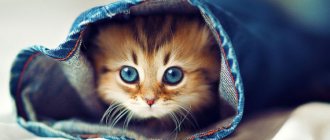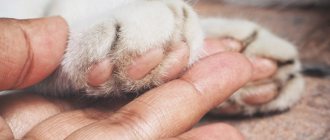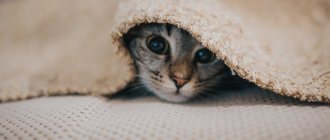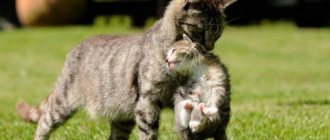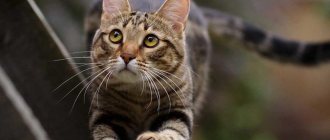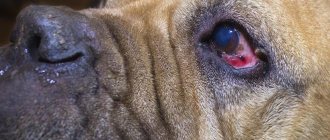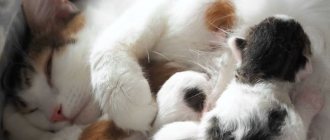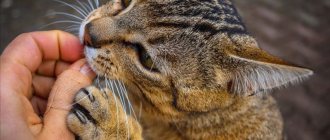6266Pavel
Among hundreds of varieties of domestic cats, cat breeds with green eyes are especially popular.
Independent and affectionate, smooth-haired and fluffy, large and miniature breeds are being improved, delighting breeders and bringing happiness to the lucky owners of purrs. In February 2021, the international club of cat lovers “Cat Fancier's Association” took into account 42 new breeds that were bred in different countries. How to find green eyes among all the diversity of the cat kingdom?
© shutterstock
Gray cat with green eyes: breed and photo
The green color of the eyes harmonizes perfectly with the smoky gray coat, which was given a more aristocratic name among breeders and felinologists, and the gray color turned into “blue”. It is not at all surprising that the combination of blue fur and magical green eyes became the reason for the formation of several magnificent breeds.
Russian blue
Which cat breeds have specific eye colors?
The color of the iris, like the color of the coat, certain characteristics of the breed (fur length, weight, body shape, etc.) are inherited. Different breeds have their own characteristics, including the shade of the iris. Certain colors are included in the list of characteristics approved by international standards, and if a kitten is born with an atypical eye color, it may be disqualified. What representatives of the cat family look like with different eye shades can be seen in the photo below.
Yellow eyed cats
Burmese Shorthair One of the most common iris colors is yellow.
What breeds are characterized by yellowish, orange, golden eyes? Most often, warm, sunny shades are found in ginger cats, and this color occurs in many breeds. Golden eyes are also combined with a gray, white, brownish, smoky, striped, tricolor coat.
Characteristics of yellow-eyed cat breeds:
| Breed name | Coat color | Characteristic |
| British Shorthair |
| The breed was bred in the 19th century. The body is squat, the head is round, the legs are short and thick. |
| Canadian Sphynx | Hairless cat | Registered in 1966. Lack of fur is caused by mutations. |
| Burma | Chocolate with dark brown areas. | Registered in 1934. Medium size, rounded head, thick and soft fur. The color of the eyes changes depending on the lighting. |
| Somalia |
| Descended from the Abyssinian breed, as a result of mutation the hair became long. The body is elongated, large, but graceful. Well-furred tail, like a fox's. |
| Persian | About 100 varieties of color:
White cats are a separate subspecies of the breed and often have congenital deafness. | One of the oldest long-haired breeds. A distinctive feature is a small and snub nose, a long body. |
| Exotic | About 100 varieties of color. | Bred by crossing Persian cats with American Shorthairs. A characteristic feature is short hair, pronounced stop, cheeks. |
| American Shorthair | More than 80 color and pattern options - from solid to striped. | They were brought to America by settlers from Europe. Large, powerful body. Very calm and affectionate. |
| Scottish lop-eared | Plain:
Striped:
| A distinctive feature is that the ears are curved downwards. |
| Bombay | Black | Miniature "panther" with smooth short hair. |
Black color allowed
If the previous breed is called the Bombay Black, then among the short-tailed American females there may also be black individuals. This fluffy dog is susceptible to training and has high intelligence. If your pet is accustomed to wearing a harness, he will be happy to take walks with his owner in the park.
The color includes various shades of black and tabby - black stripes on a fawn or gray background.
Siberian cat
These majestic creatures are covered with thick hair with a water-repellent effect, have a double and dense undercoat and “pants” on the hind legs. They are excellent hunters of mice and rats. They are easy to care for and tolerate almost any weather conditions well.
Oriental cat
The elegant blue-black cat with charcoal pads is the most “refined” among its relatives. There are a total of 42 types of colors in individuals of this breed. Affectionate and friendly pets are not pretentious, but they should be protected from the cold.
Devon Rex
Large shining eyes combined with “elven” ears are mesmerizing. The neck is thin and the head is slightly flattened. The beauty walks on high legs and proudly wears her long tail. The animal is energetic and affectionate, and is also well adapted to life in the city.
Turkish Angora
The long-haired cutie was brought from Byzantium. Fluffies can be painted in different colors, including pure black, with white splashes and other options.
Norwegian forest
The fur of representatives of this breed is smooth and thick. Sideburns can be seen on the cheekbones. In winter, a fluffy chic collar “falls” over the shoulders and neck. The ears are pointed with tassels, the tail is long, the legs are high with heavy pads. The color is varied, but always the same color.
American Curl
The small cat has hard ears that turn outward. The animal's character is spontaneous.
The Curl is the first cat breed in which the standard allows short-haired and long-haired varieties.
These cats have come into fashion in Russia relatively recently. At the moment, Maine Coons are extremely popular in our country. The main features of this breed are its truly gigantic size (weight up to 13 kg), the presence of a large “hooligan” box (the place where the mustache grows) and fluffy, rather long fur.
Cats are really big and often even look scary. However, the temperament of representatives of this breed is actually very soft and flexible. Despite their somewhat “street” appearance, the animals are exclusively indoor animals. Maine Coons have retained their hunting instinct. That is, they can catch mice and birds, for example, with the same zeal as other cats.
We suggest you read: Non-contagious diseases of bees and their treatment
However, Maine Coons, unfortunately, cannot stand up for themselves on the street at all. Representatives of this breed have great love for all living creatures, including neighbor cats or even dogs. Such an animal can approach a pack of wild dogs completely without fear, which, of course, will end badly for him.
Blue-black wool for Maine Coons is considered one of the standards. Often such cats also have emerald irises. A photo of a black Maine Coon cat with green eyes can be seen below.
The rich green color of the iris is characteristic of the black solid color, along with yellow and copper, but a black cat with green eyes cannot be of any breed. For example, black Persians, exotics, Britons, and Scottish Folds have only orange or yellow eyes.
Green ones are allowed in cats of oriental and aboriginal breeds. It is interesting that there is a breed in which black solid color is the breed-forming one - this is the Bombay cat, although according to the standard it is supposed to have yellow, amber or golden-colored eyes, and green will be a disadvantage. Let's look at the breeds of black cats with green eyes.
A Maine Coon cat of a solid black color with green eyes evokes awe - the strong, powerful bones of these cats, their large lynx ears with tassels and the often stern expression of their faces immediately make it clear who is boss in the house, although their character is quite peaceful and flexible .
The breed standard allows all shades of green iris, the main thing is that the eye color is in harmony with the color and is as pure and bright as possible.
Korat
And here is the Korat - another rare and ancient breed: a photo of a gray cat with green eyes will not leave any Thai indifferent. The name itself is consonant with one of the provinces of Thailand, and for good reason. A great many national traditions and beliefs are associated with this cat. According to local residents, korat brings prosperity, wealth and success.
The coat of cats of this breed is thin and not thick, like that of Russian Blues and Nibelungs, but has the same color - silver tipping with a characteristic iridescence. The eyes of a Korat cat are large and round, and the color of the iris is olive green. Other coat and eye colors are not allowed by the standard.
Emerald iris color is rare
Initially, the most common eye color for cats with any coat was green.
But subsequently, breeders became somewhat carried away by breeding new breeds with unusual eye colors: blue, bright orange, etc. Therefore, today, unfortunately, cats with green irises have become a relatively rare occurrence. There are quite a lot of furry animals with tea-colored, marsh or, for example, khaki-colored eyes. But cats with emerald green or bright grass irises are very difficult to see today.
But still, if you try, you can find a cat with such eyes even today. Even an outdoor cat can have a bright emerald iris. Of course, this eye color is allowed by the standards of many breeds.
Causes of yellowing eyes in cats
Yellowing of the sclera in a cat is not noticeable due to the large size of the iris. Even an attentive owner notices the icterus in the whites of the animal’s eyes against the background of a general deterioration in the condition of his pet, a change in his appetite or yellowing of the inner surface of the ear or the skin of the pads. Not only the sclera or the lining of the ear turns yellow, the cat’s entire skin changes color, the tongue and all visible mucous membranes become lemon-colored. This condition is called jaundice.
Jaundice, as a symptom, always indicates a high concentration of a substance such as bilirubin in the animal’s blood. It is a derivative product during the normal processing of hemoglobin from red blood cells, which the body needs to transport oxygen to every cell and organ. If hemoglobin is processed at an accelerated pace (under pathological conditions), then soon too much bilirubin will accumulate. Then yellowing of the whites of the eyes and mucous membranes occurs.
In addition to jaundice, your cat will have other signs of illness:
- indigestion;
- flatulence;
- diarrhea or vomiting;
- extreme thirst and excessive urination;
- labored breathing;
- hepatic encephalopathy;
- dark urine and light feces;
- Also, in the last stages of the disease, the animal may experience internal bleeding, and, as a result, blood in the urine and feces.
This condition is far from normal. The animal eats poorly, loses a lot of weight, may suffer from severe pain, and fall into a coma. In the absence of timely medical intervention, the pet may die.
Such a manifestation as jaundice is usually differentiated into parenchymal, mechanical or obstructive and hemolytic forms. Each form is caused by serious pathological processes in the cat’s body:
- Hepatic or parenchymal jaundice is caused by functional and organic diseases of the hepatobiliary system. Hepatitis (inflammation of the liver parenchyma), cholangitis (inflammation of the bile ducts) cause icterus in animal tissues.
- Severe liver diseases: cirrhosis (replacement of the organ parenchyma with connective tissue with loss of its functionality) and cancer lead to yellowness of the skin and mucous membranes. Even excessive accumulation of triglycerides (fats) by liver cells - hepatocytes - leads to yellowness of the sclera and skin.
- Baked obesity, or lipidosis. In this condition, liver cells develop into fat cells. The liver gradually loses its functions, which means the animal may die. Its causes are the cat's excess weight, diabetes, malignant tumors, and hyperthyroidism. Unfortunately, in almost half of the cases the cause of this dangerous disease cannot be established.
- The use of certain medications can lead to changes in the liver and excess bilirubin (bile pigment) in the cat's blood. It is the bile pigment that colors tissues a beautiful yellow color. These medications include: first generation antihistamines (diazolin), NSAIDs (paracetamol), antifungals (griseofulfin).
- Infectious diseases of viral etiology (viral peritonitis), protozoal infections (toxoplasmosis), bacterial pathologies and some parasitic infections cause liver pathology and the release of large amounts of bilirubin into the blood.
- Incorrect use of insectoacaricides (veterinary products intended to combat parasitic insects, in particular ticks). Many insectoacaricides have a strong toxic effect on hepatocytes. Salts of heavy metals also have a similar effect.
- Obstructive jaundice. Obstructive jaundice develops when there is an obstruction to the outflow of bile. Most often it develops due to exacerbation of cholelithiasis (cholelithiasis). If concretions (stones) block the bile duct, the animal develops biliary colic, the temperature may rise, and it is bothered by severe pain in the right hypochondrium. The mucous membranes, sclera and skin turn yellow.
- Inflammatory diseases of the gallbladder and its ducts, their stenosis, pancreatitis, pancreatic cancer can lead to impaired outflow of bile and jaundice. Any tumors of the abdominal cavity that grow into the tissue of the bile ducts or mechanically compress the gallbladder and its ducts can cause large amounts of bilirubin to enter the bloodstream and cause yellowing of the animal’s tissues.
- Hemolytic jaundice. Hemolytic jaundice is caused by hemolysis (destruction) of red blood cells directly in the blood vessels. This happens in some diseases (hemolytic anemia). The cause of hemolysis of erythrocytes may also be severe hypophosphatemia, aggravated by magnesium deficiency. Hemolysis can develop as a result of a cat’s body’s reaction to a blood transfusion. The entry into the blood of hemolytic poisons (zoocoumarin) and medications (warfarin) also leads to the destruction of mature red blood cells.
- Parasitic diseases: feline hemobartonellosis, feline piroplasmosis can lead to hemolysis of hemoglobin. Parasitism of certain helminths that attack vital organs can lead to hemolytic jaundice. This disease in veterinary practice is called dirofilariasis.
Singapore
According to legend, this rare breed of miniature cats comes from Southeast Asia. Singapura cats have a very unusual coloring - sepia agouti. The ivory body is complemented by dark brown ticking, giving the coat a sandy tint. Singaporeans are characterized by not only yellow, but also yellow-green, as well as bright green eyes. You can learn interesting facts about this breed from our article “Singapore cat and more.”
Devon Rex
“Little fairy elf” is how you can describe this charming cat with curly fur, originally from Devonshire. The breed standard recognizes all colors and any shades of eyes are allowed, but they must be uniform and in harmony with the color of the coat. So, if you wish, you can also find a black kitten with green eyes in nurseries.
All the breeds described above are quite large in size. Those pet lovers who want to have a small black cat with green eyes should pay attention to the Devon Rex. Tiny representatives of this breed look really cute and cute.
The Devon Rex's coat is not too long and wavy. There are no pure black shades in the standards of this breed. However, if you wish, you can purchase a Devon Rex in silver-black, ash-black or black-blue. Green eyes are very common in cats of this breed.
Due to their cheerful, playful disposition, Devon Rex cats are often called eternal kittens. Animals are active and insatiably curious. Such a cat will have to pay quite a lot of attention. Among the advantages of this breed, many pet lovers also include high intelligence and fearlessness.
Khao Mani breed: distinctive features
The snow-white cat from Thailand, called Khao Mani, or diamond eye, has a very ancient pedigree. It is easier to care for such a cat than a Persian, because it is a short-haired breed. This species got its name because of the special cut of the eyes - they are brightly outlined and shine like diamonds.
It is better not to get this cat for those people who are rarely at home, because she does not like loneliness and does not tolerate it well. In character, cats of this species are closest to Siamese.
Abyssinian breed and Somalia
These ticked cats also have green or yellow eyes. The main thing, as the standard says, is that their color is intense, without intermediate shades. We wrote more about the characteristics of Abyssinian cats here.
Somalis are long-haired relatives of the Abyssinian cat, so their eye color options are the same as those of the Abyssinian cat.
American Bobtail
A distinctive feature of this cat is its bob tail. Representatives of this breed look very funny. Breeders often sell black American Bobtails with white spots on the face or chest. According to breed standards, this is not considered a marriage. Black and white cats with green eyes also look quite impressive.
The standards for this breed recognize 3 shades of black:
- dark chocolate;
- carbonic;
- black and ash.
These cats are considered a family breed. They treat all people living in the house equally with love. Bobtails do not require too much attention from their owners, but they will also take part in active games with pleasure.
Breeds of chinchilla colors
This group includes all tipped (shell) and shaded (shaded) colors, both silver and gold. All cats with chinchilla coloring have emerald eyes, or an aquamarine and blue-green iris (the exception is cats with red pigment, their eyes are yellow or copper).
The combination of emerald eye color with silver and gold fur looks great, especially considering the expressive eyeliner and nose. This color is found in Persian and exotic cats, as well as in British and Scottish fold cats.
Black wool: features
This fur color initially is also not uncommon for cats. The coat of a purebred cat may appear black if its color is defined as:
- jet black;
- dark chocolate;
- silver-black;
- black and blue, etc.
Fur of this color, as well as emerald eyes, are acceptable by the standards of many modern breeds. Of course, you can also have an outdoor kitten at home with this combination of fur and eye color. But you can, of course, only find such a pet with a certain amount of luck. Genes in street cats manifest themselves extremely unpredictably.
Turkish Angora: characteristics of the breed
There are various breeds of white cats, but perhaps the most famous of them is the Turkish Angora - a harmoniously built, flexible and graceful animal with large, almond-shaped, wide-open eyes, set somewhat obliquely. Originally, this type of cat was only white with blue, orange, green, amber, yellow or different colored eyes.
There are various breeds of white cats, but perhaps the most famous of them is the Turkish Angora. The tail of this beauty is much longer than that of other breeds, resembles a peacock feather and can reach the shoulders.
This breed was formed in Turkey, where it is still highly valued today. Cats with different eyes are especially valued, despite the fact that white Angoras with different-colored eyes are deaf in the ear on the same side as the blue eye.
Ragdoll
This cat is just perfect for those pet lovers who want to have a calm and affectionate pet. Representatives of this breed are distinguished by their phlegmatic and lazy character. Even the name “ragdoll” itself translates literally as “rag doll.”
The weight of a cat of this breed can reach up to 9 kg. That is, these animals are very large. Ragdolls have a fur structure that is unlike any other cat. Since representatives of this breed have very thin hairs on their bodies, their fur is more reminiscent of a rabbit's.
Actually, black is not included in the standard of this breed. However, ragdolls with dark coffee or black-chocolate coat are allowed for exhibitions. These cats look almost jet black. Pets with green eyes of the Redgall breed are also quite common.
Silver tabby cats
Quite often, green eye color can be found in silver tabby cats (British, Scottish, American Shorthair and many other breeds, as well as in ordinary, but no less charismatic yard cats). However, in comparison with chinchillas, it is not nearly as rich and bright. Most likely, breeders, paying great attention to the quality of the color itself, its pattern, have not yet had time to pay due attention to eye color.
Let's make a reservation that silver tabby cats and cats are also characterized by yellow and yellow-green eyes.
Norwegian Forest Cat
A large black cat with green eyes of the Norwegian Forest breed is incredibly beautiful, although it is quite rare. Much more often, representatives of this native breed have common colors with agouti factor and white. The Norwegian Forest is a semi-long-haired cat, and its truly long, thick fur once helped these cats survive in the harsh Scandinavian climate.
We suggest you familiarize yourself with: Ixodid subcutaneous ear mites in cats
The breed standard allows all green shades of the iris, including yellow-green.
What determines the color of a cat's eyes?
All kittens are born with blue eyes, and only after a few weeks the color of the iris begins to change. What is this connected with? The iris consists of two layers - mesodermal and ectodermal. In the anterior part there are chromatophore cells that contain the pigment melanin, which is responsible for eye color.
The lower the amount of melanin in the iris, the lighter the eye color. There is almost no pigment in blue irises, a little more in green eyes, and cats with golden eyes have the most coloring pigment.
The color of the iris is inherited. Just like coat color, it is associated with a combination of different genes. Inheritance occurs according to a complex pattern, so even experienced breeders cannot accurately predict the color of the eyes of future kittens. Looking at his parents, it is possible to predict the color of the iris in 50–60% of cases.
Heterochromia in the Angora cat
Heterochromia is an unusual phenomenon that occurs not only in cats, but also in humans. In this case, the color of the left and right eyes is different - one of them is blue, and the other may be green or golden. This feature is due to heredity.
Orientals
This is another breed that is definitely worth considering for those who want to have a black, green-eyed pet. A feature of Orientals is, first of all, a very unusual “lynx” appearance. Their muzzle and ears form an inverted triangle. These cats have shiny fur and look very elegant and graceful.
One of the characteristic colors for this breed is ebonite, that is, coal-black. Orientals with such fur usually do not have a single light spot on their body. Even the nose and paw pads of these cats are black.
The character of Orientals is quite flexible. These cats adore their owners and constantly demand attention from them. One of the characteristics of this breed is its loud voice, which Orientals love to use with or without reason.
Green eyes in Orientals, including blacks, are quite common. Moreover, the iris of such cats can have a variety of shades - from swamp to bright grassy. The eyes of animals of this breed are large, almond-shaped. That’s why orientals with a green iris look incredibly impressive. A photo of a black cat of this breed is presented below.
Breeds of long-haired cats: the beginning of history
There are two versions of the origin of long-haired cats:
- In the cold northern climate, long hair protected from frost and helped animals survive the long winter.
- Representatives of the southern regions acquired a long-haired coat to improve heat exchange - a thick layer of hair prevented the cat’s body from overheating in direct sunlight.
Later, in the 19th century, there was a great migration of cats to the European continent, where interbreeding began.
This is interesting! There are more than 250 cat breeds in the world, a third of them are long-haired animals.
Application
The ancestors of the Russian Blue hunted in the harsh northern climate.
And although today these felines do not have to think about food, they have retained their hunting instinct.
These cats hunt wherever they can. Even in the city, the Russian Blue finds an object of hunting: it catches flies, mosquitoes and butterflies.
She can watch for mice for hours.
Care and maintenance
Oriental cats do not have an undercoat to protect them from the cold. Therefore, it is advisable to keep them in warm rooms where there are no drafts. Otherwise, caring for them comes down to basic hygiene and periodic washing.
- The Oriental's eyes and ears are regularly wiped with a cotton pad moistened with boiled water or a special product purchased at a pet store.
- The cat's claws wear down on the scratching post. But if necessary, they are carefully shortened with a nail cutter, trying not to injure living tissue.
- Oriental teeth are brushed weekly with a silicone brush and non-foaming paste. This simple procedure will help get rid of plaque and prevent the formation of stone on your cat's incisors and fangs.
- The fur coat of a furry pet is regularly combed with a special brush or rubber mitten. An Oriental Shorthair cat is simply wiped with a piece of clean, damp cloth. Representatives of the breed are bathed no more than 3-4 times a year. This is done using a special shampoo that matches the animal’s coat type.
Grooming
Hair care for cats depends on the breed and physical condition of the animal.
- Long-haired and semi-long-haired pets need regular brushing. The procedure must be repeated daily, and during molting - several times a day.
- When caring for a black cat with short hair, special combs and brushes are used that collect small hairs.
Important! The “fur coat” of any cat is an indicator of its health. If the fur loses its shine or falls out excessively, you need to reconsider the animal’s diet and show your pet to a veterinarian.
Health
Russian Blues, like Norwegian Forest Cats and Egyptian Mau, were not bred artificially. They belong to natural breeds.
Therefore, they have strong immunity and good health. They live a long time and very rarely get sick.
Russian Blues are not afraid of drafts and cold temperatures. They do not have any genetic breed diseases.
Although they, like other felines, can suffer from diseases typical of cats.
Vaccinations
For the first eight weeks, kittens are protected by maternal immunity. The kittens are then vaccinated.
Only healthy animals can be vaccinated.
Suitable age is 2.5–3.5 months. For this purpose, combined vaccines against rhinotracheitis, panleukopenia, and calcivirus are used.
Vaccination takes place in several stages. Interval – 3–4 weeks.
Before vaccination, kittens are given anti-worm medications.
Russian Blue is one of the most hassle-free cats to keep.
After a month has passed from the date of the last comprehensive vaccination, kittens are vaccinated, like dogs, against ringworm.
The rabies vaccine is given at 3–4 months of age. It must be repeated annually.
Cornish Rex
A charcoal coat also adorns representatives of the Cornish Rex breed, emphasizing the extraordinary wavy structure of the coat and giving the cat a special elegance. The breed standard allows any eye color, but the color of the iris must be pure, intense and in harmony with the coat color.
What canned food tastes best for cats?
RESEARCH ATTENTION! You and your cat can take part in it! If you live in Moscow or the Moscow region and are ready to regularly observe how and how much your cat eats, and also remember to write it all down, you will receive FREE SET OF WET FOOD.
Project for 3–4 months. Organizer - Petkorm LLC.
Want to participate? Call!
7
